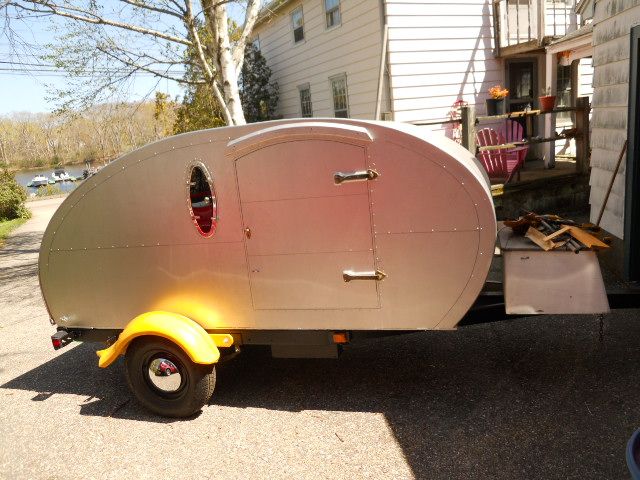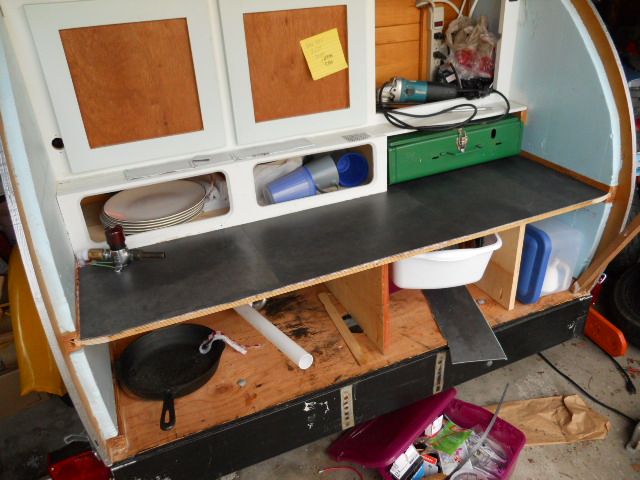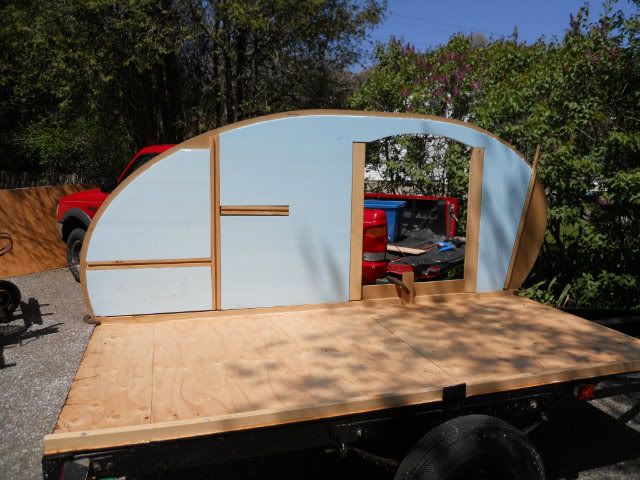I may have an opportunity to pick up a used boat trailer for ultra cheap. The hubs and bearings as well as the tires are supposed to be in good condition. I haven't seen the trailer yet, but seeing that I can get it for $50, seems like I might be able to refit it and use it for a teardrop. Anybody have any ideas good bad or otherwise regarding this possibility. What should I be thinking about when I go see this trailer over the thanksgiving holidays?
Thanks
Boat Trailer
4 posts
• Page 1 of 1
Re: Boat Trailer
Look for rust. Even though they are usually hot dip galvanized (that plated silver stuff), the fasteners and suspension parts are not usually, so can be rusty... especially if used in saltwater. Check the wheels for rust, too.
Look at where the tongue joins the main frame of the trailer. A lot have a tilt feature with a pivot point there. This is a wear point. On my boat trailer the twist from the typical side mounted tongue jack caused the pivot bolt holes to wallow out and the pivot tabs to twist. I had to do a weld repair/upgrade to restore the bolt hole dimensions, add a bolt sleeve thru the tongue tube, and gusset this area up so that it would no longer flex; then cold galvy spray to treat the metal.
Look to see if the tongue can be shortened easily (usually they can); most boat trailers have very long tongues.
Look at the tongue jack. Is it intact, does it work, if not can it be easily changed out?
Can the extra boat related stuff (winch, spare tire mount, bunks/rollers) be easily removed? Most of these are usually modular, so probably, but factor that in. Maybe you can resell these things.
Take a taillight lens off and look at the condition of the light sockets. If these are corroded, factor the cost of new lights, and maybe even a wiring kit (unless you plan on having new lights and wiring strung up thru the cabin anyway).
Look at the tires for dry rot, cracks, gouges, and wear.
Look to see if the cross members suit your needs. Most boat trailers are modular (having multiple bolt patterns for features like axle location and bunk mounting), and can be easily reconfigured by removing some bolts and sliding things around. However, the xmbrs often times have a "V" shape to clear the boats keel and depending on your cabin floor design can be an issue (if doing a drop floor it might help, for a simple plywood floor it could mean more wood framing is required).
Most smaller boat trailers have slipper leaf springs (the rear portion of the leaf spring is "S" shaped and slides in a captured slot on the underside of the frame), of which I am not a big fan. I prefer double eye springs with pivoting rear shackles. There are plenty of slipper springs out there and they work fine... heck, my boat trailer has them, but for a road going trailer and especially for an off road or forest service road trailer, my preference is double eyed springs. The slippers can slap and make noise.
Consider the load rating of the trailer; is it close to the weight that you predict to be hauling while loaded down for camping? If under rated it's a "no go"; just walk away. If over rated you will have a stiff/bouncy ride, or you will need to factor in making changes (removing a leaf from each pack or changing to softer springs). Higher load rated tires have stiffer side walls and can contribute to a harsher ride on a lighter load. If the load rating of the trailer is not readily apparent on a tag or label plate, look at the tire side wall numbers, measure the axle tube diameter, and look at the wheel hub bolt pattern (four lug, 5 on 4-1/2, etc.); these can all provide an indication of the load rating.
Higher load rated boat trailers are likely to have hydraulic surge brakes. Some people are okay with that on their campers, but most prefer electric brakes.
Look at the coupler. It should be stamped with the max load rating for the coupler (not necessarily the same as the actual trailer load rating which will likely be less) and ball size. Does it have a 4-flat wire connector or other? Is it compatible with your TV setup? Does it look to be in good condition? My boat trailer had been jackknifed before it came to me and the coupler was twisted to the point that the owner was using a 1-7/8 ball because the specified 2 inch ball would no longer fit... VERY NOT RECOMMENDED! I put a new 2 inch coupler on for a few bucks.
That's what I have off of the top of my head; I'm sure others will pipe in, too.
Good luck!
Look at where the tongue joins the main frame of the trailer. A lot have a tilt feature with a pivot point there. This is a wear point. On my boat trailer the twist from the typical side mounted tongue jack caused the pivot bolt holes to wallow out and the pivot tabs to twist. I had to do a weld repair/upgrade to restore the bolt hole dimensions, add a bolt sleeve thru the tongue tube, and gusset this area up so that it would no longer flex; then cold galvy spray to treat the metal.
Look to see if the tongue can be shortened easily (usually they can); most boat trailers have very long tongues.
Look at the tongue jack. Is it intact, does it work, if not can it be easily changed out?
Can the extra boat related stuff (winch, spare tire mount, bunks/rollers) be easily removed? Most of these are usually modular, so probably, but factor that in. Maybe you can resell these things.
Take a taillight lens off and look at the condition of the light sockets. If these are corroded, factor the cost of new lights, and maybe even a wiring kit (unless you plan on having new lights and wiring strung up thru the cabin anyway).
Look at the tires for dry rot, cracks, gouges, and wear.
Look to see if the cross members suit your needs. Most boat trailers are modular (having multiple bolt patterns for features like axle location and bunk mounting), and can be easily reconfigured by removing some bolts and sliding things around. However, the xmbrs often times have a "V" shape to clear the boats keel and depending on your cabin floor design can be an issue (if doing a drop floor it might help, for a simple plywood floor it could mean more wood framing is required).
Most smaller boat trailers have slipper leaf springs (the rear portion of the leaf spring is "S" shaped and slides in a captured slot on the underside of the frame), of which I am not a big fan. I prefer double eye springs with pivoting rear shackles. There are plenty of slipper springs out there and they work fine... heck, my boat trailer has them, but for a road going trailer and especially for an off road or forest service road trailer, my preference is double eyed springs. The slippers can slap and make noise.
Consider the load rating of the trailer; is it close to the weight that you predict to be hauling while loaded down for camping? If under rated it's a "no go"; just walk away. If over rated you will have a stiff/bouncy ride, or you will need to factor in making changes (removing a leaf from each pack or changing to softer springs). Higher load rated tires have stiffer side walls and can contribute to a harsher ride on a lighter load. If the load rating of the trailer is not readily apparent on a tag or label plate, look at the tire side wall numbers, measure the axle tube diameter, and look at the wheel hub bolt pattern (four lug, 5 on 4-1/2, etc.); these can all provide an indication of the load rating.
Higher load rated boat trailers are likely to have hydraulic surge brakes. Some people are okay with that on their campers, but most prefer electric brakes.
Look at the coupler. It should be stamped with the max load rating for the coupler (not necessarily the same as the actual trailer load rating which will likely be less) and ball size. Does it have a 4-flat wire connector or other? Is it compatible with your TV setup? Does it look to be in good condition? My boat trailer had been jackknifed before it came to me and the coupler was twisted to the point that the owner was using a 1-7/8 ball because the specified 2 inch ball would no longer fit... VERY NOT RECOMMENDED! I put a new 2 inch coupler on for a few bucks.
That's what I have off of the top of my head; I'm sure others will pipe in, too.
Good luck!

KC
My Build: The Poet Creek Express Hybrid Foamie
Poet Creek Or Bust
Engineering the TLAR way - "That Looks About Right"
TnTTT ORIGINAL 200A LANTERN CLUB = "The 200A Gang"
Green Lantern Corpsmen
My Build: The Poet Creek Express Hybrid Foamie
Poet Creek Or Bust
Engineering the TLAR way - "That Looks About Right"
TnTTT ORIGINAL 200A LANTERN CLUB = "The 200A Gang"
Green Lantern Corpsmen
-

KCStudly - Donating Member
- Posts: 9640
- Images: 8169
- Joined: Mon Feb 06, 2012 10:18 pm
- Location: Southeastern CT, USA



